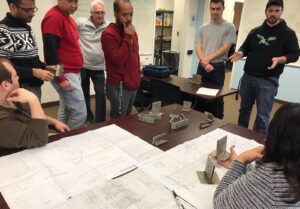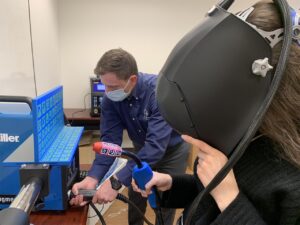 Employment challenges have been capitalizing headlines since the pandemic caused one of the most turbulent job markets in recent history. Manufacturing businesses had a whole different experience with the pandemic since the workforce challenge is not a new concept for them. US manufacturers had to step up to overcome global delays for critical products. These businesses began retooling or were being approached by customers they’ve never worked with in the past because foreign suppliers couldn’t meet deadlines. However, the workforce challenge is an issue manufacturing businesses understand extremely well. For decades manufacturers have struggled to attract and retain new talent. The skills gap continues to cause massive disruptions for these businesses but for the first time, real workforce solutions are here.
Employment challenges have been capitalizing headlines since the pandemic caused one of the most turbulent job markets in recent history. Manufacturing businesses had a whole different experience with the pandemic since the workforce challenge is not a new concept for them. US manufacturers had to step up to overcome global delays for critical products. These businesses began retooling or were being approached by customers they’ve never worked with in the past because foreign suppliers couldn’t meet deadlines. However, the workforce challenge is an issue manufacturing businesses understand extremely well. For decades manufacturers have struggled to attract and retain new talent. The skills gap continues to cause massive disruptions for these businesses but for the first time, real workforce solutions are here.
Understanding the Manufacturing Skills Gap to Bridge the Skills Chasm
‘Skills Gap’ was the name given to the massive separation between baby boomers that have an unmatched wealth of manufacturing experience and the rest of the public that has little to no hands-on experience with the industry or industrial processes. Manufacturing businesses have struggled to find new employees with the proper training and education to make them productive members of their teams. In 2011, the average age of a high-skilled manufacturing worker was 56. Fast forward 10 years later and these individuals are approaching retirement age. With more manufacturers retiring, the Skills Gap has turned into the Skills Chasm.
The Bureau of Labor Statistics reported in December of 2022 that there are over 424,000 manufacturing job openings. Open positions are common. Businesses can’t seem to find applicants that have any experience, certifications, education, or training that will allow them to safely step into manufacturing roles. As schools stepped away from developing these skills and media pushed college as the only path toward a career, interest faded and the talent dried up. A 2021 study conducted by Deloitte and the Manufacturing Institute (MI) paints a troubling picture. The study explained that 2.1 million manufacturing positions will be unfilled by 2023. It is expected that these open positions come with a hefty price tag. Deloitte and MI expect this inability to fill manufacturing jobs could cost the U.S. a loss of upwards of $1 trillion in GDP.
Cheap labor outside the United States allowed the nation to feel comfortable about the erosion of skilled tradespeople. Expectations that this was the new face of manufacturing caused schools to eliminate shop classes and any encouragement from parents or mentors to pursue industrial careers seized almost entirely. Millennials were a lost generation to manufacturing but this is not the end. Workforce solutions are presenting themselves. Workforce development, professional growth opportunities, and incredible hands-on manufacturing training technology are beginning to bridge the disruptive skills gap.
Setting the Stage for Modern Manufacturing
 When most people think about the industry, they imagine an outdated picture of what manufacturing looked like decades ago. No safety procedures, no digital technologies, no respect for the career, but the world is changing. Modern manufacturing looks extraordinarily different than it did in the early 1900s. Even businesses that work mainly by hand, creating massive metal structures or classic textile operations take safety extremely seriously. Most utilize incredible digital technologies that connect the shop floor with their ERPs and supply chain partners. Along with progress inside shops, public perception is changing. A newfound respect for industrial careers is beginning to form. People are starting to pay attention to the high school graduate that developed a skill and put it to work. Students that followed today’s conventional path of college directly after high school struggle to find a job that will pay the bills while young manufacturing professionals are thriving.
When most people think about the industry, they imagine an outdated picture of what manufacturing looked like decades ago. No safety procedures, no digital technologies, no respect for the career, but the world is changing. Modern manufacturing looks extraordinarily different than it did in the early 1900s. Even businesses that work mainly by hand, creating massive metal structures or classic textile operations take safety extremely seriously. Most utilize incredible digital technologies that connect the shop floor with their ERPs and supply chain partners. Along with progress inside shops, public perception is changing. A newfound respect for industrial careers is beginning to form. People are starting to pay attention to the high school graduate that developed a skill and put it to work. Students that followed today’s conventional path of college directly after high school struggle to find a job that will pay the bills while young manufacturing professionals are thriving.
The general public may assume that these careers are low-paying. This could not be farther from the truth. New Jersey Manufacturing Extension Program (NJMEP) produces the ‘Manufacturing Industry Report’ each year which compiles data from highly reputable sources including the Bureau of Labor Statistics. In 2020, the average annual compensation for a manufacturing employee was over $94,000. The industry also provides highly competitive benefits package when compared to service careers. Along with competitive pay and benefits, job security is leaps and bounds beyond most industries. During the COVID-19 pandemic when most organizations were laying off millions, many manufacturers were looking for more people to help offset the shortage of foreign-produced goods. These businesses need people and when the individuals they hire have skills that are incredibly hard to come by, they are respected and nurtured since they are a critical asset to that company.
Higher education is a goal of many. People often assume that once a person finds a job after High School instead of going directly to college it will mean the possibility of getting a diploma is out of the question. This isn’t true. There is no “right” path. Seeking trade skills and employment after High School is a fantastic way to begin a journey toward higher education. Manufacturing businesses often provide tuition reimbursement or will even pay for relevant credentials. Individuals that work in an industrial setting are potentially even better set up to succeed in a higher education environment. People that work, gain life experience, and earn a living before going to college have a high chance of taking education more seriously. Additionally, these individuals might even be able to graduate without any student debt by combining tuition reimbursement and having the funds to pay for their education. Choosing a career doesn’t mean a person has to stop improving themselves.
Manufacturing Employment Solutions and Current Progress
 Manufacturing Extension Programs are located throughout the nation. There is at least one MEP center in every state including Puerto Rico. Each act independently but with workforce challenges cited as a primary issue among manufacturers, many provide workforce development and recruiting opportunities for local manufacturers.
Manufacturing Extension Programs are located throughout the nation. There is at least one MEP center in every state including Puerto Rico. Each act independently but with workforce challenges cited as a primary issue among manufacturers, many provide workforce development and recruiting opportunities for local manufacturers.
In New Jersey, NJMEP has a strong workforce focus. Their workforce division, the Pro-Action Education NetworkTM works to address the skills gap from all levels; high school curriculum and engagement, USDOL Registered Apprenticeships, educating the manufacturing industry on retention best-practices, and low barrier-to-entry hands-on training.
Progress is being made. The average age of an employed factory worker dropped dramatically to 37, from 56 in just 10 years. Working together will be the only way to continue this trend and steadily reverse the skills gap. Local high schools, community colleges, local workforce programs, state and federal governments, manufacturers, MEP centers, close collaboration is proving itself beneficial.
Pre-Apprenticeship programs start in high schools. Funded through the NJ DOL’s Pre-Apprentice in Career Education (PACE) grant, a program was created that brings together manufacturing workforce programs like NJMEP, and local high schools to develop and deliver industry-relevant curriculum to students all over New Jersey. These students are educated on manufacturing safety, industrial processes, and can get hands-on with the most advanced training equipment available. NJMEP works closely with manufacturers, providing training and consulting services. This connection to both a pool of young adults with manufacturing skills and ‘MADE in New Jersey’ manufacturing business leaders directly and actively refills the talent pool, steadily closing the skills gap.
US DOL Registered Apprenticeship programs are structured curriculum delivered to incumbent workers; individuals that have been employed by a manufacturer for at least 90 days. An apprenticeship can take on many different forms but the core concept is the delivery of hands-on training hours, coupled with substantial and highly structured classroom course material. Apprentices must pass a series of tests and are held to a higher responsibility standard as they are being upskilled. Participants pass through safety, manufacturing process, quality, and maintenance training all the while working with a mentor to hone a skill for a specific manufacturing operation. This employee is given the opportunities to advance their career, develop professionally, and the manufacturer gains a loyal, productive employee. Apprenticeship programs are a proven model but just now regaining popularity in the United States. The effectiveness of US DOL Registered apprenticeship programs improves exponentially when coupled with the Pre-Apprenticeship program developed by New Jersey’s MEP.
Collaborative partnerships are the only way to make progress and continue closing the manufacturing skills gap. An investment of time and energy is required by all parties to succeed. Private businesses, academia, governments, organizations of all kinds need to work together and break down the stigma while building up communities. NJMEP’s example is just one of many opportunities all over the nation. Connecting with local partners, workforce networks, high schools, and nationwide communities will foster a stronger pool of highly qualified, highly productive manufacturing professionals. Having this refreshed workforce allows the entire nation to benefit by ensuring it does not miss out on that estimated $1 trillion lost GDP because of the current state of the skills chasm.
SOURCES:
- https://www.shrm.org/hr-today/trends-and-forecasting/research-and-surveys/Documents/4-13%20Skills%20Gap%20Briefing.pdf
- https://www.bls.gov/news.release/pdf/jolts.pdf
- https://www.nam.org/2-1-million-manufacturing-jobs-could-go-unfilled-by-2030-13743/?stream=workforce
- https://www.zippia.com/factory-worker-jobs/demographics/



















